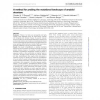148 search results - page 24 / 30 » The evolutionary capacity of protein structures |
BMCBI
2007
13 years 9 months ago
2007
Background: Detection of adaptive amino acid changes in proteins under recent short-term selection is of great interest for researchers studying microevolutionary processes in mic...
BMCBI
2007
13 years 9 months ago
2007
Background: Matching functional sites is a key problem for the understanding of protein function and evolution. The commonly used graph theoretic approach, and other related appro...
BIOINFORMATICS
2011
13 years 1 months ago
2011
Motivation: Proteins of all kinds can self-assemble into highly ordered β-sheet aggregates known as amyloid fibrils, important both biologically and clinically. However, the spe...
BMCBI
2010
13 years 9 months ago
2010
Background: One of the most challenging aspects of biomolecular systems is the understanding of the coevolution in and among the molecule(s). A complete, theoretical picture of th...
BMCBI
2008
13 years 9 months ago
2008
Background: Prediction of transmembrane (TM) helices by statistical methods suffers from lack of sufficient training data. Current best methods use hundreds or even thousands of f...


